|
ENO ONELINK HAMMOCK SHELTER
SYSTEM
TEST SERIES BY BRIAN
HARTMAN
LONG-TERM REPORT
October 14, 2017
CLICK
HERE TO SKIP TO THE FIELD REPORT
CLICK
HERE TO SKIP TO THE LONG-TERM REPORT
TESTER INFORMATION
| NAME:
|
Brian Hartman
|
| EMAIL:
|
bhart1426ATyahooDOT com |
| AGE:
|
49
|
| LOCATION:
|
Central
Indiana |
| GENDER:
|
M
|
| HEIGHT:
|
5' 9" (1.75
m) |
| WEIGHT:
|
150 lb (68.00
kg) |
I have been backpacking for over
20 years throughout Indiana, Ohio, Kentucky and most recently in Western USA. In
addition to backpacking I enjoy family camping with my wife and kids and being
outdoors in general. I would describe myself as a mid weight backpacker. I use
fairly light weight equipment and gear but still like to bring more than the
bare essentials with me while on the trail.
INITIAL REPORT
PRODUCT INFORMATION &
SPECIFICATIONS
Manufacturer: Eagles Nest
Outfitters, Inc 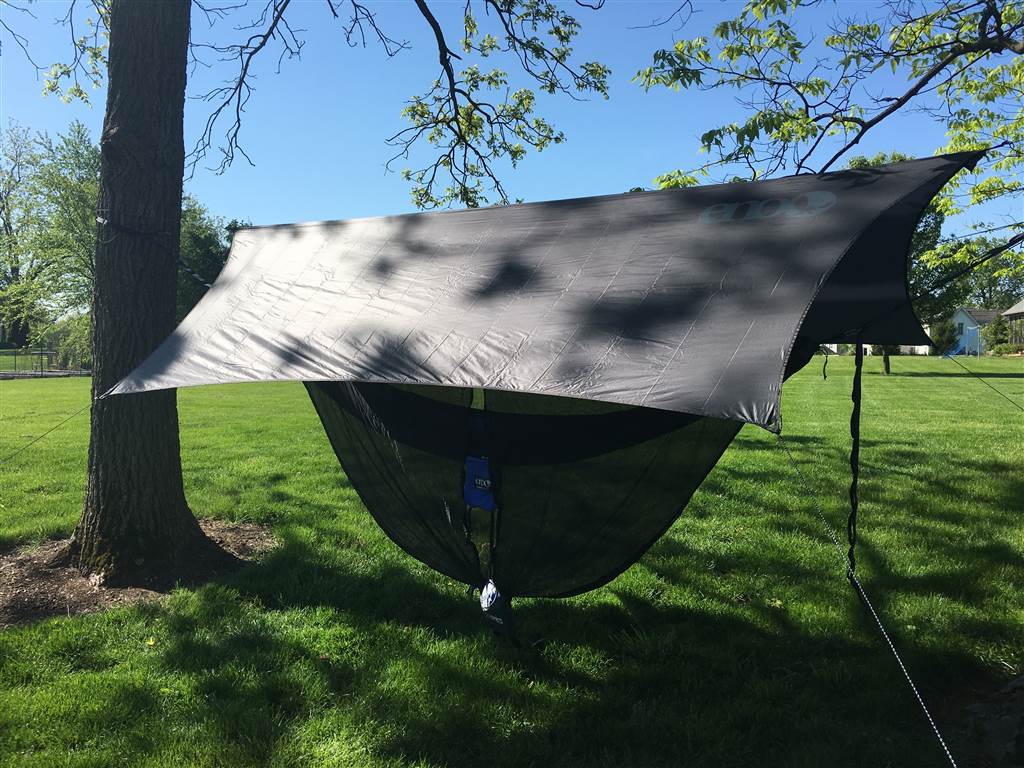
Year of Manufacture: 2017
Manufacturer's
Website: http://www.eaglesnestoutfittersinc.com/
MSRP:
US $251.67
Listed Weight: N/A
Measured Weight: 60 oz (1.7 kg)
Warranty:
2 Years
Details of the Individual Components that are part of my OneLink
system:
SingleNest Hammock:
Weight: 16 oz (454 g)
Material: 70D
High Tenacity Nylon Taffeta
Packed Dimensions: 4 x 5 in (10 x 12.7
cm)
Unfolded Dimensions: 112 x 55 in (284 x 139.7 cm)
Atlas
Straps
Weight: 11 oz (312 g)
Weight Capacity: 200 lbs (90.5 kg) per
strap
Material: Polyfilament webbing
Packed Dimensions: 5.6 x 3 x 2 in (14
x 7.6 x 5 cm)
Unfolded Dimensions: 108 x 1 in (274.3 x 2.5 cm)
ProFly
Sil Rain Tarp
Weight: 16 oz (454 g)
Material: 15D Silicone Impregnated
Ripstop Nylon
Folded Dimensions: 8 x 4 in (20.3 x 10.2 cm)
Unfolded
Dimensions: 126 x 76 in (320 x 193 cm)
6 Point Guy System
Stitched and
Taped Seam
LineLoc Fasteners for Fast and Secure Line
Tensioning
Guardian Bug Net + Insect Shield
Weight: 16 oz (454
g)
Material: 950 square inch No-see-um netting
Folded Dimensions: 4.5 x 4
in (11.4 x 10.2 cm)
Unfolded Dimensions: 112 x 51 in (284 x 129.5 cm)
Full Length Zippered Entry
Durable and Effective Insect
Shield
Tarp Stakes
6 in (15.2 cm) Aluminum Tarp Stakes - quantity
six
Weight: 0.3 oz (8.5 g)
OneLink (hereafter called ENO, OneLink,
or shelter system) is a complete hammock shelter system consisting of ones
choice of hammock, tree straps, rain tarp, and bug net. In addition to these
items, every OneLink system includes six tarp stakes and a stuff sack. OneLink
is made by Eagles Nest Outfitters, Inc (ENO) which is an 18 yr old company
located in Asheville, NC. ENO's product line includes over a dozen hammocks as
well as numerous rain tarps, hammock straps, bug nets, underquilts, and other
items.
When ordering the OneLink system the first item that needs to be
specified is the hammock, and the one I chose was the SingleNest. The
SingleNest is a gathered end hammock, measuring 112 in (284 cm) long, 55 in
(139.7 cm) wide and designed for one person. The hammock is made of 70D High
Tenacity Nylon Taffeta and comes with a built-in stuff sack and two aluminum
wiregate carabiners on the gathered ends of the hammock. All in, the SingleNest
weighs a mere 16 oz (454 g) which is not bad for a backpacking hammock. If one
wanted to shave a few more ounces the carabiners are removable, although I am
leaving everything stock during testing.
The next item I chose was the
Atlas straps. They are patented tree straps, each with 15 loops, that allow the
hanging position of the hammock to be adjusted in 4 in (10.2 cm) increments.
The beauty of the Atlas straps in conjunction with the carabiners is that
hammock adjustments can be made without ever having to tie or untie a knot. The
Atlas straps are capable of holding 200 lbs (90.5 kg) each for a combined total
of 400 lbs (181 kg). Of course the carabiners can be attached to any rope or
webbing system, but having used the Atlas straps previously, I prefer them
because of how quick and easy they make set up and tear down.
Next, for
the rain tarp I selected the ProFly Sil rain tarp which is a lightweight
alternative to ENO's standard ProFly rain tarp. The ProFly Sil is made of 15D
Silicone Impregnated Ripstop Nylon with taped seams and weighs 16 oz (454 g) in
contrast to the ProFly, which is made of polyurethane coated ripstop nylon and
weighs 22 oz (624 g). Also included in my shipment were six lightweight 6 in
(15.2 cm) aluminum tarp stakes for securing the rain tarp. The tarp stakes came
in their own storage bag as did the rain tarp.
Finally, for my choice of
bug net I chose the Guardian Bug Net with Insect Shield. Insect Shield is a
proprietary blend of Permethrin insect repellent for use against mosquitoes,
ticks and no-see-ums. It is designed and applied to fabric fibers by the
manufacturer in such a way that it remains effective for long periods of time,
up to several months or more, and is supposedly effective through 70 washings.
Back to the Guardian Bug Net, it has its own built-in stuff sack and includes a
96 in (244 cm) ridgeline and plastic clips for hanging the bug net. It is made
of no-see-um netting to further protect against mosquitoes and other flying
insects while still allowing air circulation. It has a full length zippered
entry and pull cords on each end to close the pass thru holes that are there to
allow the hammock to attach to the tree straps.
INITIAL IMPRESSIONS
I was very excited when my
OneLink system finally arrived in the mail. My first thought was how small and
lightweight the box felt for all of the items that must be inside. My second
thought was where did I put my pocket knife, as I hurried around the house
trying to find something sharp to cut through the fiber reinforced packing tape
that I couldn't tear open with my hands. After finding a scissors and opening
the box, I first saw the OneLink stuff sack in navy blue with ENO's logo proudly
displayed on the front along with illustrations of a hammock, straps, bug net
and rain fly. The stuff sack is made of ripstop nylon and has taped seams as
well as a wide mouth roll top opening, something typically reserved for dry
bags. Could this be a watertight bag for storing my entire sleep system? Way
to go ENO!
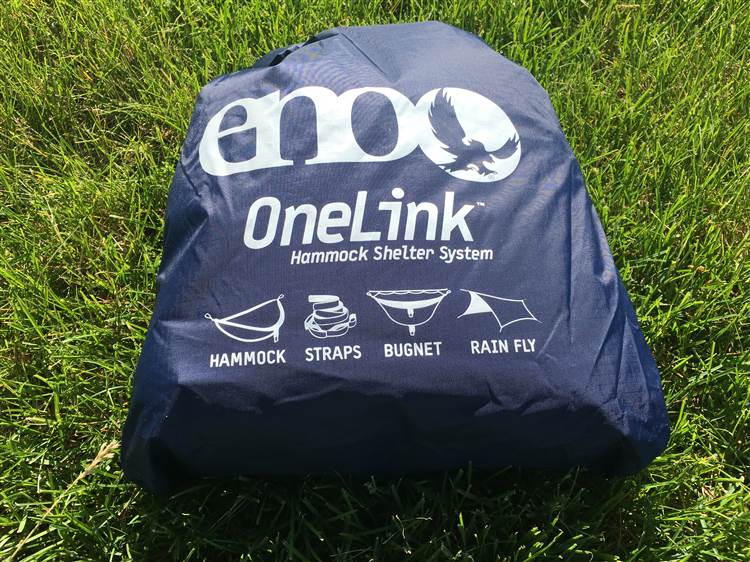 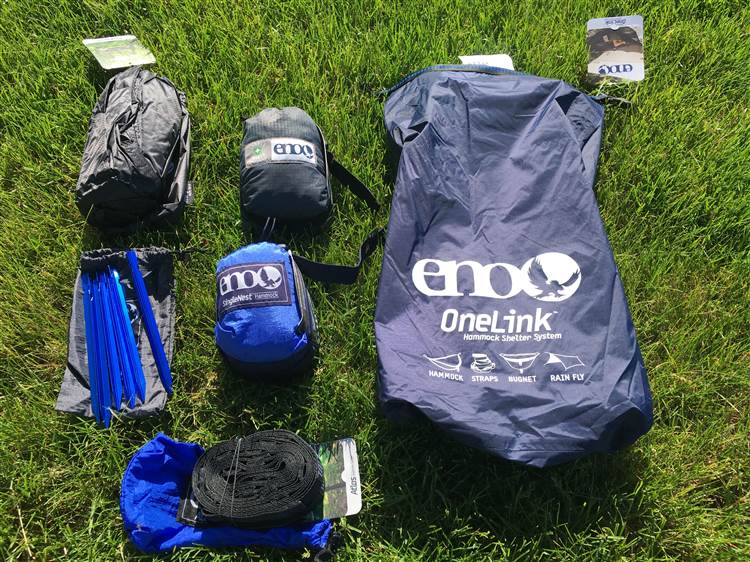
Inside the stuff sack was the hammock,
tree straps, rain tarp, bug net, and tarp stakes all neatly packaged in their
own bags. At this point I was so excited I blurted out, 'very impressive', to
which my wife gave me a look from the kitchen which basically said 'your nuts'.
Normally at this point I would have opened each item individually and examined
them in detail for workmanship (stitching, loose threads etc.) but instead I
grabbed the stuff sack, tossed everything inside and headed out to my backyard
to set it up (see upcoming section).
After returning from my backyard a
few hours later, I sat down in my family room and inspected all of the items one
by one. Upon final inspection I found the hammock, straps, rain fly and bug net
to be in perfect condition with no rips, tears or loose threads anywhere. All
seams were stitched tightly and the rain fly had taped seams for additional
waterproof protection. The hammock itself was triple stitched and soft to the
touch; in addition it is purported to be breathable which should help during the
hot summer months. As noted earlier I'm already familiar with the Atlas straps
from having used them previously and they are a wonderful invention. I also
found the zipper on the bug net to be easy to grasp and I had no problems
opening or closing it.
READING THE INSTRUCTIONS
Each item in the OneLink Shelter
System had its own hang tag. In addition there was a hang tag on the OneLink
stuff sack which listed all of the items I received. The other hang tags
provided product details similar to what I noted above with the exception of a
hang tag provided by Insect Shield which stated that their product would repel
mosquitoes for up to six months or 25 washings. One last thing I learned from
the hang tags is that all of ENO's products have a 2 year
guarantee.
Regarding care ENO recommends keeping the hammock and other
items out of sunlight when not in use to keep them from fading and getting
brittle from UV exposure. In regards to washing the hammock and/or bug net in a
washing machine ENO recommends removing the carabiners and then washing them in
cold water with a mild detergent. Alternatively the hammock can be hand washed
and air dried which is what I typically do with my other hammocks.
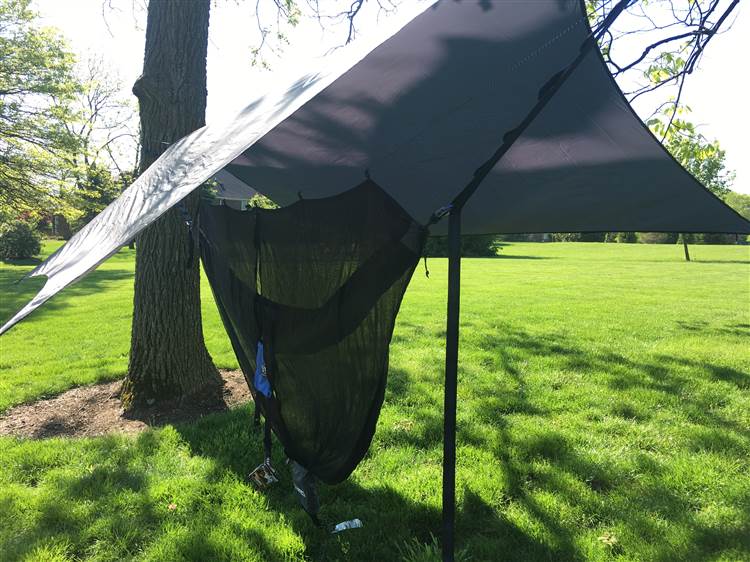 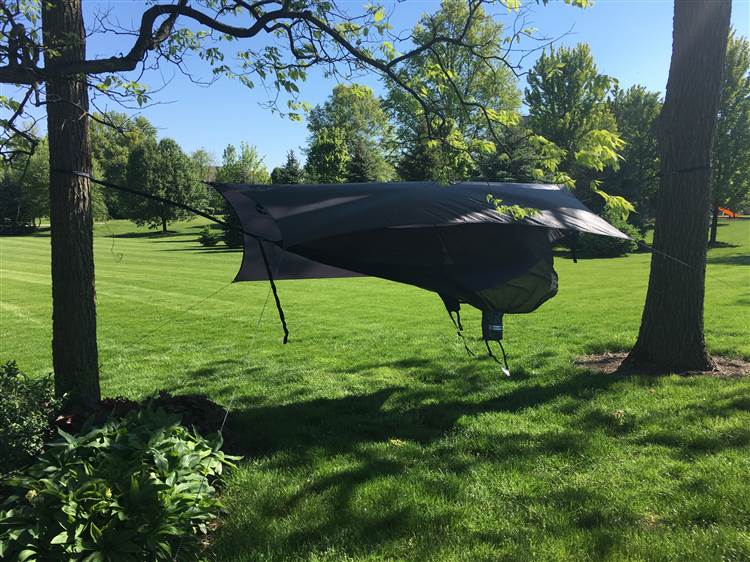
TRYING IT OUT
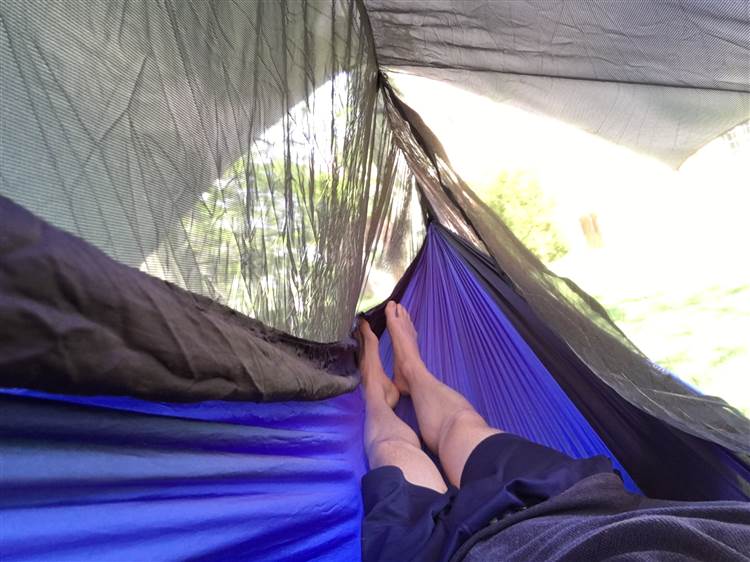
My first time setting up the OneLink
Shelter System was a breeze. Luckily there are two trees in my backyard that
are the perfect distance apart for hammocking so after opening the shipping box
I immediately headed outside and laid the contents of the stuff sack on my
lawn.
To setup OneLink I first grabbed the Atlas straps and wrapped them
around each tree, then I unfolded the hammock from its built-in stuff sack and
clipped the carabiners to the straps. That took about 2 minutes. Next I
unfolded the bug net from its built-in stuff sack, opened the zipper, then
unclipped the carabiners one by one and threaded them through the open ends of
the bug net before securing them back to the Atlas straps. Afterwards I tied
the bug net ridgeline to the Atlas straps then clipped the bug net to the
ridgeline to complete its installation.
Adjusting the height and angle of
the hammock at this point was as simple as moving the carabiners from one loop
of the Atlas straps to the next, with no knots to tie or untie. For the final
step I draped the rain fly over the ridgeline and tied it to the trees then
staked out its four corners. Total time for setup was just over 6 minutes.
Once finished I climbed into the hammock and laid there for 20 minutes
watching the clouds go by, contemplating how well all of the items in the
OneLink system work together. I was almost asleep when my kids came racing
outside to climb in the hammock. Oh well, time to take some photos for this
report.
SUMMARY
I really like the ENO OneLink
System. It includes everything needed for overnighting in a hammock in a very
nice waterproof stuff sack. I also love the fact that each item is in its own
individual bag so its easy to separate items and take only what's needed for a
particular trip. I look forward to getting this system into the field for some
serious testing.
FIELD
REPORT
FIELD LOCATIONS AND CONDITIONS
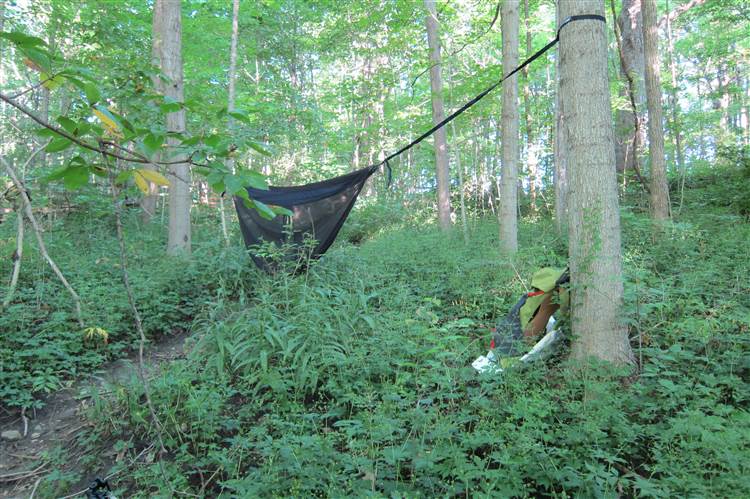
During Field Testing I took the ENO OneLink on four
backpacking trips and slept in it a total of six nights. Temperatures during my
outings ranged from the low 60's F (16 C) to the upper 80's F (31 C) and
included sunny skies as well as thunderstorms. I hiked a total of 26 mi (42 km)
during this test period in elevations that ranged from 520 to 805 ft (158 to 245
m) above sea level.
My first trip of the test period was a two-night
backpacking trip to Southern Indiana (IN). Since nighttime temperatures were
forecast to be in the mid 70's F (24 C), I decided not to bring my reflective
foil pad and opted not to set up the bug net on the first night. Instead I
brought a blanket, figuring I could drape it over me if I got cold in the middle
of the night and I figured it would also protect me from bugs. The blanket
turned out to be a necessity as temperatures dropped 4 or 5 degrees below
expectations and I woke up cold around 3 am. As it turned out, I also missed
not having my pad, not for warmth but it would have protected my backside from
getting bitten up by mosquitos during the night.
My second trip with the
ENO OneLink was an overnighter to the Hardin Ridge area of the Hoosier National
Forest. This time I brought my reflective pad in addition to the blanket and I
fared much better. Temperatures on this outing ranged from 89 F (31 C) during
the heat of the day to 67 F (19 C) at night. The hammock worked wonderfully on
this trip and I slept quite well. The following morning, I broke camp early as
my family and I were going boating and we wanted to get on the water as quickly
as possible.
My third trip of this test period started out as a nice
weekend but quickly turned sour as a thunderstorm that was predicted to arrive
at the end of the weekend came early and was more intense than originally
expected. I spent the latter half of this trip huddled under the rain tarp
trying to stay warm and dry as wind, lightning and buckets of water engulfed me.
My last trip during Field Testing was an overnighter to a local park in
Central Indiana (IN). Temperatures were mild on this trip, not getting above 74
F (23 C) during the day and dropping to 62 F (16 C) at night. I set up camp
soon after arriving at the park and spent the rest of the evening hiking before
returning to camp. I hiked approximately 6 mi (9.6 km) on this trip.
PERFORMANCE IN THE FIELD
Below are my thoughts on the ENO
OneLink system after spending two months in the field with it.
Setup /
teardown: On my first trip during Field Testing I stopped hiking around 7 pm so
I would have plenty of time to pitch the hammock. I wasn't worried that it
would take long to setup, I simply wanted to do so during daylight hours since
this was my first time in the field with the ENO OneLink. As for where I would
camp, I had a general area in mind, based on how far I needed to travel the
following day, but I wasn't tied to any particular spot. After several minutes
of searching I found two trees that were the right distance apart and not too
big in diameter and chose the area between them for my campsite. The Atlas
straps worked wonderfully and soon I had the hammock pitched and fairly level.
Although I mentioned it in my Initial Report I want to reiterate how easy it was
to adjust the height and angle of the hammock by simply moving the carabiners
from one loop of the Atlas straps to the next, with no knots to mess with.
In preparation for my second night in the field I unpacked the bug net,
unzipped it, and unclipped each side of the hammock so I could thread them
through the ends of the netting before reclipping them to the Atlas straps. In
no time at all I had the hammock and bug net in place and was left deciding if I
wanted to pitch the rain fly, which I ended up doing. The rain fly went up
slower than the hammock and bug net because I needed additional cordage to
secure it between the trees I had selected.
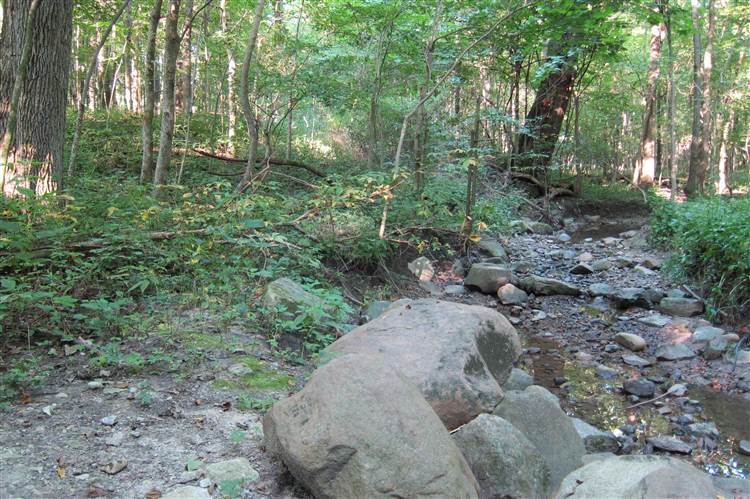
On my third trip, it started raining while I was still
15 minutes from camp. I got out my rain jacket and quickened my pace, looking
for suitable trees along the way, but most of them were too far apart so I
continued hiking and eventually arrived at my destination. Since it was already
raining I pitched the rain fly first and then the hammock and bug net. Setup
for all three was quick and easy once again thanks to the Atlas straps. As the
rain got stronger I could hear thunder in the distance. At that point, I knew
the thunderstorm that was supposed to hit the following day was barreling down
on me, and it was just a matter of time before it was on top of me.
The
weather on my fourth and last trip of this test period was much better with
sunny skies and mild temperatures that felt like the beginning of fall. Before
leaving home, I decided to affix the hammock inside the bug net so I could pitch
them together instead of separately, thus eliminating one step in my setup
process. I also slipped snakeskins over them to make setup easier. Once in
the field and at my campsite I found that doing these two things cut my setup
time in half. In addition, it reduced my tear down time by two thirds.
Consequently, in the next few weeks I plan to buy snakeskins for the rain tarp
as well.
Entry and exit: I've had numerous opportunities to get into
and out of the hammock / bug net and am very comfortable doing so. Once in the
hammock it is possible to shift around but it's not easy and trying to change
clothes in the hammock is not nearly as easy as in a tent. During Field Testing
the bug net zippers operated smoothly and opened wide enough that I could get
myself and pretty much anything else I wanted into and out of the hammock. A
few of the larger items I fit through the opening zippered entry were my
reflective foil pad, sleeping pad, sleeping bag, and blanket.
The bug
net was big enough that it never interfered with the hammock regardless of the
angle at which I hung the hammock. In fact, the bug net is probably too big as
it often touches the ground and invariably gets wet or dirty. My other concern
with it being so long is that it often hangs in the weeds that are growing up
between the trees in summer and often those weeds contain thistles that could
tear the bug net and poison ivy that could get on the hammock or me when I pack
up.
Comfort / sleeping: I've been a hammock camper for several years
now and have gotten used to sleeping on my back. However, it did take some time
for me to feel comfortable 'hanging' as I grew up sleeping on my stomach. With
the ENO I've had no problems getting a comfortable sleep other than my knees are
sore when I wake up. I contribute that to the fact that the ENO is shorter than
most hammocks so it hangs differently and my knees get over extended, unless I
remember to prop them up with an article of clothing before going to sleep.
The nylon fabric, which the hammock is made from, is very soft and the
SingleNest hammock is plenty wide for me. I've tried the DoubleNest, which is
EMO's wider hammock but it is just not comfortable as there is so much extra
material on the sides that it droops over top of me and onto my face when I'm
sleeping to the point where I feel like I'm going to suffocate. I don't have
this problem with the SingleNest hammock as there isn't as much gathered
material. In addition to being soft to the touch, the hammock is also quiet and
breathable and I have yet to sweat in it.
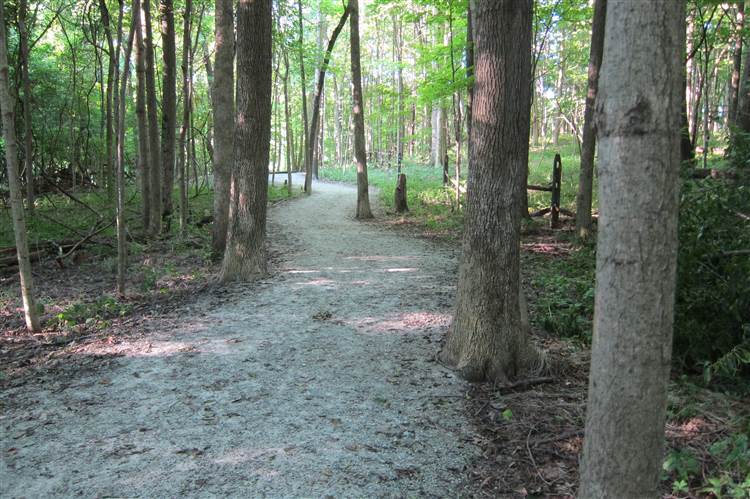
As for improvements I would like to see, it would be
nice if the SingleNest had a double fabric layer like ENO's Reactor hammock.
With the Reactor, a sleeping pad can be fitted between the two layers which
prevents it from moving around. In addition, the pad gives the hammock a
slightly flatter lie in my opinion. I also wish the ENO hammocks came with a
ridgeline which is something I've gotten used to as it eliminates guesswork
since the hanging angle is already established.
Bug Net: The bug net did
a great job of keeping away bugs. The no-see-um-mesh prevented even the
smallest of insects from attacking me at night. In addition, the bug net was
long enough that it didn't interfere with the hang of the hammock and prevented
mosquitos from getting close enough to bite my back. As mentioned above I think
the bug net is at least 1 ft (30 cm) too long which makes it prone to getting
wet, dirty and possibly ripped.
Rain Fly / waterproofness: When selecting
options for my OneLink system, I opted for the Silicone impregnated Profly rain
tarp and am happy I did. It did a great job protecting me from torrential rain
during my third outing, with the caveat that rain blew in from the sides of the
hammock that faced North and West as the thunderstorm moved through. Despite
not being quite large enough, the Profly SIL stopped nearly 5 in (12 cm) of rain
from falling on top of me.
One other problem I ran into in the
thunderstorm was rain that came in from the suspension system. Rain running
down the tree trunks soaked my suspension lines and then flowed across the
carabiners and into my hammock. After returning home I researched drip lines
and water breaks and so that I now have two different systems I can try out
during the next rain storm. One is based on a YouTube video by Derek Hanson
(thanks Derek!) and the other is from an online article I found that discussed
water breaks.
Durability: My ENO OneLink system held up well to the past
two months of testing. Despite some snags in the bug net from catching on
thorns, the rest of the system, consisting of Atlas straps, hammock, tarp and
bug net, is fine.
SUMMARY
The ENO OneLink system performed
well during Field Testing. It was comfortable, durable, easy to setup and tear
down and provided good protection from rain and biting insects.
LONG-TERM
REPORT
LONG-TERM TEST LOCATIONS AND
CONDITIONS
During Long Term Testing I took
the ENO OneLink on two trips for a total of four nights and 14 mi (22.5 km) of
backpacking. Both trips took place at elevations below 1,000 ft (304.8 m) with
temperatures ranging from the upper 40's F (9 C) to the mid 70's F (25 C).
Skies were clear to partly cloudy with no precipitation.
FIELD LOCATIONS
AND CONDITIONS
Trip #1
Location: Southeastern IN
Elevation:
883 ft (269 m)
Temperature: 61 F to 77 F (16 C to 25 C)
Skies: Partly
sunny
Conditions: Calm to light breeze
Distance hiked: 8 mi (12.8
km)
Trip #2
Location: Southeastern IN
Elevation: 855 ft (260
m)
Temperature: 49 F to 70 F (9 C to 20 C)
Skies: Clear
Conditions:
Breezy
Distance hiked: 6 mi (9.7 km)
Both of my trips during this test
period were to my favorite camping spot in Southeastern IN. On my first trip, I
wore shorts, socks and a long sleeve synthetic shirt to bed, and slept on a
sleeping pad while covering myself in a synthetic blanket. On my second trip, I
wore the same clothes to bed but woke up cold in the middle of the night so I
put on thermal underwear, a sweatshirt and beanie. After warming up, I slept
comfortably through the rest of the night.
PERFORMANCE IN THE FIELD
The ENO OneLink performed well
during Long Term Testing. The system was easy to setup, take down and pack in
my backpack; in addition, the hammock was comfortable to sleep in, the bug net
kept the mosquitos away, and the rain fly kept me dry despite lots of morning
dew. Best of all, I slept well on both trips, only waking up twice during the
night, once because I was cold and a second time because nature
called.
Setup: Pitching the OneLink was simple thanks to ENO's Atlas
straps and carabiners. They make setup so easy, in fact, that after four months
of testing and two previous reports doting on them, I still feel the need to
talk about them. They were durable and extremely easy to use, and they proved
themselves every time I went hammocking. The weight that they added to my pack
was negligible given that they allowed me to set up and/or tear down the hammock
in a matter of minutes. The Atlas straps never stretched, there were no knots
to tie so I didn't have to worry about slippage, and if my hammock wasn't level
after initial setup, which it rarely was, all I had to do was unclip the
carabiners and connect them to a different loop on the Atlas straps to adjust
the height of either side of the hammock. I only found a couple of instances
where the Atlas straps weren't long enough to span the trees I was wanting to
hang from. If that were a more common occurrence, I would simply buy ENO's XL
straps which are 54 in (137 cm) longer than the ones I'm currently
using.
Comfort: I consistently slept well in the ENO OneLink during Long
Term Testing. Climbing into the hammock after a long day on the trail was
wonderful, not to mention the fact that the SingleNest could be used as a place
to sit if it was raining during the day (see Field Report) or if I just wanted
to get off my feet for a while. I also liked the fact that I didn't need to
find a level campsite as is the case when tent camping. Since most backpacking
hammocks have notoriously tight quarters I hung two pocket organizers from my
self-made ridgeline and used them to keep my phone, pocket knife and flashlight
among other things.
One problem I experienced during Long Term testing
was that my sleeping pad kept sliding out from underneath me. An integrated
sleeve in the hammock would keep the pad from moving around at night. I think a
sleeve would also keep it from curling up on the sides and ends which would
create a flatter lie, something that a lot of stomach and side sleepers would
like to see in their hammocks.
Protection: I used the bug net on both
trips and it performed well keeping the mosquitos and other flying insects away
from me so I could sleep uninterrupted. In terms of durability it held up well
other than a few snags I picked up during Field Testing. I had no problems
getting into and out of the hammock while using the bug net although there's so
much extra material hanging below the hammock that I found myself stepping on it
if I wasn't careful. The zipper on the bug net worked fine and I had no
problems opening or closing it.
The rainfly did a good job of keeping my
blanket and other items from getting damp from the morning dew. I lowered it on
one side during my second trip so that it also blocked a cold breeze that blew
through my campsite during the night. The aluminum stakes that ENO provided
worked well for tying off the ends of the rain fly; they were lightweight and
easy to push into the ground although they were sometimes painful to pull out
with bare hands due to their sharp edges.
Pros
easy to set up and
tear down
comfortable to sleep in
durable
compact storage
size
Cons:
wish it had a built-in sleeve to keep my sleeping pad in
place
SUMMARY
The ENO OneLink is a great
hammock system and it performed well during Long Term testing. I'm excited to
try it in colder temperatures this fall with a homemade underquilt.
This
concludes my Long Term Report and this test series for the ENO OneLink system.
I would like to thank ENO and BackpackGearTest.org for giving me the opportunity
to test this hammock.
This report was created with the BackpackGearTest.org
Report Writer Version 1. Copyright 2017. All rights reserved.
Read more reviews of Eagles Nest Outfitters gear
Read more gear reviews by Brian Hartman
|




